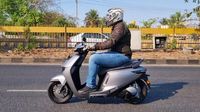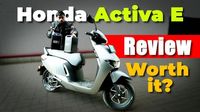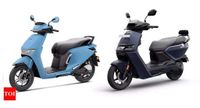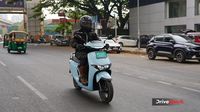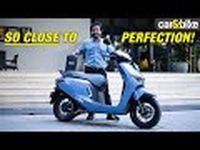The Honda Activa e electric scooter enters the competitive world of electric mobility, offering an alternative to traditional petrol-powered scooters. The Activa e has been positioned as a promising entry into India’s rapidly expanding electric scooter market, competing against established models like the Ather Rizta. This review covers its design, performance, and practicality, particularly focusing on how well it meets the demands of everyday users.
Launched on March 25, 2025, the Activa e is priced at Rs. 1.17 lakh for the Standard variant and Rs. 1.52 lakh for the RoadSync Duo variant, both ex-showroom. Honda Motorcycles & Scooter India is optimistic about the Activa e's potential, leveraging the iconic brand's reputation for reliability. The scooter features a sleek design characterized by an elegant apron-mounted LED headlight and LED daytime running lights (DRLs) positioned on the handlebar cowl. Available in five color options—Pearl Shallow Blue, Pearl Serenity Blue, Pearl Misty White, Matt Foggy Silver Metallic, and Pearl Igneous Black—the Activa e also incorporates silver accents and flush-fitting pillion footrests, adding to its overall aesthetic appeal.
One of the standout features of the Honda Activa e is its advanced technology. The top variant includes a 7-inch TFT display that offers Bluetooth connectivity for incoming call alerts and navigation assistance. While the display is clear, it lacks touch functionality, necessitating navigation through a toggle switch on the left handlebar. Moreover, a USB charging port provides additional convenience for users.
Performance-wise, the Activa e is powered by a swingarm-mounted motor delivering 6 kW of peak output, allowing the scooter to accelerate from 0-60 km/h in just 7.3 seconds. Riders can choose between three riding modes—Eco, Standard, and Sport—with a maximum speed reaching 80 km/h. Furthermore, the Activa e utilizes two swappable 1.5 kWh lithium-ion batteries, giving it a total capacity of 3 kWh. According to Honda, these batteries provide a range of 102 km per charge.
While Honda boasts about the Activa e's battery technology, potential buyers need to consider the implications of using a battery swapping system. The Activa e does not support home charging; instead, users must rely on Honda's battery swapping stations to recharge. Currently, Honda has established 84 swapping stations in Bengaluru, with plans to expand to major cities like Mumbai and Delhi. The accessibility of these stations might significantly impact riding habits and purchasing decisions as users plan their routes around the availability of charged batteries.
In comparison to rivals, especially the Ather Rizta, the Activa e stands out with its unique offerings but also faces challenges. The Ather Rizta is available in various configurations, with two battery options: a 2.9 kWh version, delivering a range of 123 km per charge, and a larger 3.7 kWh battery that achieves a range of 159 km. While the Rizta's motor is slightly less powerful at 4.3 kW, it emphasizes practicality with features like reverse assist and an app providing a host of connectivity options.
Pricing for the Ather Rizta starts at Rs. 1.12 lakh for the base S model, with prices escalating based on battery capacity and features. As a result, the Activa e positions itself as a slightly premium but reliable option compared to its competitors.
The scooter's durability and build quality are also paramount. Reviews highlight the attention to detail in the Activa e's construction, which remains consistent with the renowned Activa lineage. Features such as front disc brakes and rear drum brakes enhance safety during rides, ensuring a balanced braking system that instills confidence in users.
In terms of user experience, the Activa e's swappable batteries and limited range raise an important question: Is it practical for daily commuting? While the convenience of battery swapping addresses charging time concerns, riders may find the geographical constraints of swapping stations a potential hurdle.
Ultimately, Honda's Activa e presents a compelling choice for those eager to join the electric revolution. It embodies a blend of tradition and innovation, catering to a growing market eager for sustainable mobility solutions. However, its success remains contingent upon the strategic placement of battery swapping stations and customer acceptance of this new technology model.
With the market for electric scooters only continuing to grow, the stakes are high for Honda to establish its e-scooter as a household name like the original Activa. Seeing how the Activa e competes with established models and meets the needs of modern riders will be critical to its future.
